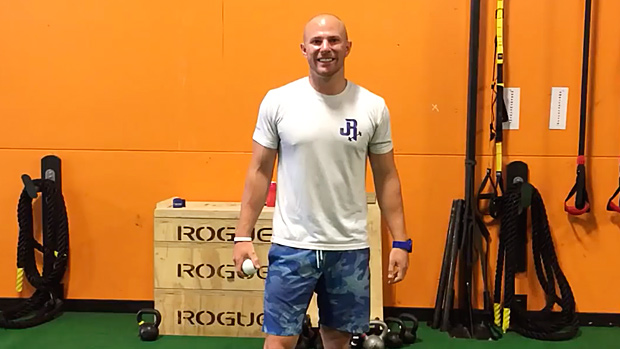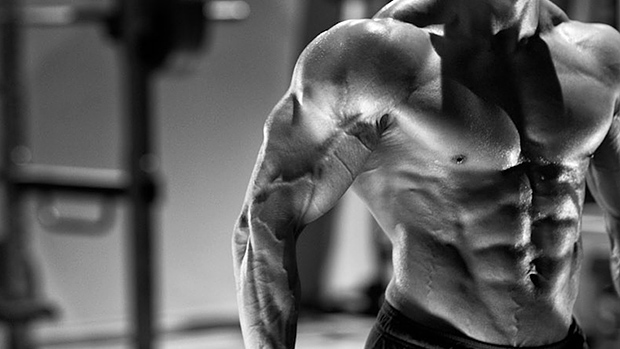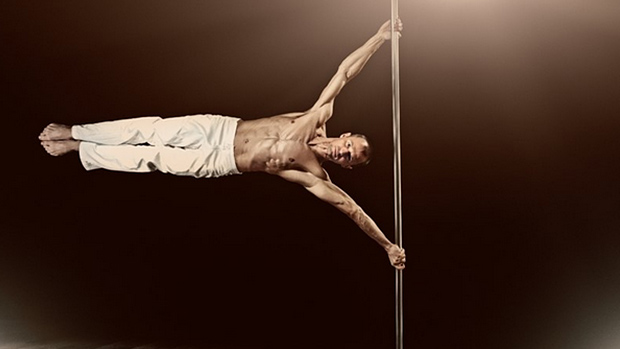If you're a lifter that's developed a back injury but still wish to make progress in the gym without causing more damage, this article is for you.
Working around back injuries is sort of like playing Russian Roulette. "Will this set of deadlifts make it feel better or cause a disc to shoot across the room and take someone's eye out?"
Hey, I've been there. I've had to learn the hard way what works for my back after getting tackled playing football, dislocating my hip from my spine, tearing a few important muscles in my low back, and having to walk with a limp for a year or two.
I still get back pain occasionally, but it doesn't stop me from training because I know what movements I can and can't do and how to limit the damage I do in the gym.
Here's a quick and dirty guide on how to lift like a man, keep your T cranked through the roof, and make figure competitors swoon from your pure awesomeness, even with back pain.
Barring any incident of radiating pain down the leg, numbness, loss of function, or obvious deformity to the spine, most back injuries aren't going to necessarily require medical intervention. Now, before the room full of gun-shy trainers reading throw up their hands and scream, "REFER THEM TO THE DOCTOR ALL THE TIME!!" the simple fact is that most back injuries will not be viewable on an MRI, X-ray, or other medical imaging report.
Here's a little known secret about spinal MRI's. A study in the New England Journal of Medicine in 1994 showed roughly 52% of the population is walking around with a disc bulge at one level, and around 38% have a disc bulge at more than one location. Many are asymptomatic, meaning there's pretty much nothing that can be done to help, short of massive invasive surgery that, in most cases, would be completely unnecessary.
Most physicians will prescribe some muscle relaxants, say "take some time off," and then send you on your way (with a bill, no less). Clearly, for the T-brethren reading, simply being told to rest and "stop training" isn't an option.
There are, however, things you can do to seewhat you should do and what to avoid in the gym. The easiest way to go about this is movement mapping. Performing a series of simple movements that can help determine which ones cause more pain or less pain, and then use the results to guide you in the gym. Further, it can give you an idea of what may be wrong and what you need to do to fix it, or who you need to see to get it fixed.
For example, one of my clients with back pain came in for me to check and see what the hell he did. When he performed a simple forward bend test, he had a nice spinal hinge in the mid-lumbar spine.
The majority of acute low back injuries will get better on their own with no intervention within 4-6 weeks, but if it's a chronic problem, the muscles will begin to atrophy and weaken, making future back injuries more likely to happen. You need to start getting your workouts on track, but you also need to have a game plan of what to do and what not to do to protect your vulnerable spine and build new slabs of beef.
Whenever you're doing any exercise with a bad back, you have to think about getting your core to support the work and reduce the chance of further injuring yourself. The best way to do this is through a concept Dr. Stuart McGill calls "super-stiffness."
By contracting all the abdominal, low back, pelvic and intercostal muscles at once, you can increase the uniform stability of the spine and limit the chance of a buckling injury or any problems with your discs.
To get this idea of super-stiffness to work for you, think about flexing your abs like you're going to show off for the ladies. Now contract the oblique muscles and low back muscles, making sure you're not contracting so hard that you can't breathe. Bonus points if you can clench your anus, draw your testes up, and bow your diaphragm down. That's a stable core, baby!
This should be done whenever you're performing any exercise listed below, as well as any type of lifting, pushing, pulling, bending, or twisting. In other words, whenever you're doing anything at all, ever.
Now that you know how to get your core correct, let's look at the specific movements that may be giving you grief.
One of the most common movement dysfunctions for low back pain (LBP) is spinal flexion. The majority of disc issues within the lumbar spine involve posterior nuclear migration and cause a bulging of the disc into the central (less common) or lateral (more common) canals, which then pushes on nerves and often leads to crippling pain.
To test this one out, simply sit in a chair and touch your toes. If that seems impossible, stop before you hurt yourself. If this is easy, try to stand upright and touch your toes. Pain or having to slowly ratchet your way down would indicate a problem and would necessitate that you avoid doing certain things.
Don't Do:
- Deadlifts, Bent-Over Rows, and Seated Rows. I definitely love my deadlifts, but if a flexion intolerant spine flare-up happens, they can be the equivalent of checking for hemorroids with a cattle brand.
- Sit-ups or any ab isolation movement that forces flexion without co-contraction of the low back muscles.
- Spinal Rotation Movements, like twists and chopping movements.
- Leg Presses. You're forced into spinal flexion under load, so it's a no-go.
- Standing Calf Raises and Back Squats. The direct compression on the discs can be uncomfortable and put even more pressure on the discs.
Do:
- Glute Hip Press. This bad mamma-jamma makes your glutes sing without placing your spine under any negative loads. Plus, jacking four plates off the floor with your butt will make the ladies check out your action.
- Front Squats or Goblet Squats. These hit the legs without straining the back, and force the spine to resist being pulled into flexion.
- Any type of chin-up, pull-up, or lat pulldown, etc. The lats play a huge role in recovery of the spine, as they wrap all the way from the shoulder down to the pelvis, and can add to the stability of the spine. Try to perform these with a T-spine extension.
- Push-Up Variations. These will increase the need for spinal stability over bench presses or dumbbell presses, and can be progressed by elevating the feet, adding chains or weighted vests, if needed.
Also: As a cool-down, McKenzie postures will help the spine reorganize itself out of a flexion bias, and help to reduce any acute flare-ups of flexion-based back pain.
Start on your stomach with your chin on your fists, and progress up to your elbows as pain allows. Hang out here for about 2-5 minutes, or until you feel your back completely relax. Bring your laptop or iPad and read TNation while you're there. All the cool kids do it.
While not as common as a flexion-based pain, extension can be just as limiting, but can easily be trained around. Most extension-related issues revolve around facet joint issues or even soft tissue compression, so movement that involves extension should be controlled or eliminated.
To test this one out, lie on your stomach and prop yourself up on your elbows. If this makes you wish for a quick death, or if it simply results in a dull ache, stop doing it and follow the recommendations below.
Don't Do:
- Back Extensions. This should be obvious, considering the name implies the movement that's causing the problem.
- Deadlifts. They can take an unholy toll on the spine, and it only takes one technical mistake, especially when you already have some sort of pain, to make the problem worse. Best to leave it alone until you feel 100 percent again. You'll manage.
- Barbell Squats. The spine has to extend, under compression and against shear forces, to squat. That's three strikes for an extension intolerant spine. Skip it.
- Overhead Pressing. The spine needs to extend to move the arm overhead. No dice.
- Rotation. Whether standing, sitting or lying down, it's a no-fly zone.
Do:
- One-Foot Squat & Row. This makes you work a squat pattern and a pull pattern, while keeping your pelvis and spine in a better alignment than you could ever do by isolating the movements.
- Dips. The combined effect of core activation for the pushing movement, plus the added distraction on your spine when you hang your body weight with no force pushing up will make your back thank you. Plus, the spine isn't in extension, so happiness all around.
- Spine-Supported Crunches. You can still get your abs on, in a safe manner. (And don't worry, this isn't a traditional crunch that gets everyone in a tizzy.) Place a hand under the small of your back, and bend one knee to get the best crunch possible for the least wear and tear on your back.
- Low Cable Bent Over Row. This requires less extension than a true bent over row, and also reduces the shear force within the vertebrae, so it will help you protect your back while you're gunning your lats.
- Rollouts, also known as Straight-arm Extensions. These force you to maintain some form of flexion throughout, or else you'll feel a small pinching sensation in your low back.
To do this one properly, think about shortening your abs, keep them locked solid, and allow your hips and shoulders to open through the movement without any movement in the lumbar spine. Don't let the TRX in the video below fool you, these will make your abs feel like they're about to explode, Alien-style, and cause a little T-disciple to bust through your gut and start yelling words of encouragement at you. See video (sans T-disciple) below.
If your back's holding you back, fight back and get in the gym again. By training around your injury and thinking about what the problem may be versus pushing through it or pussying out on it altogether, you can actually help to speed recovery and get back to a pain-free life.
Nut up, pick your labia off the floor, get in the gym and start lifting again!





